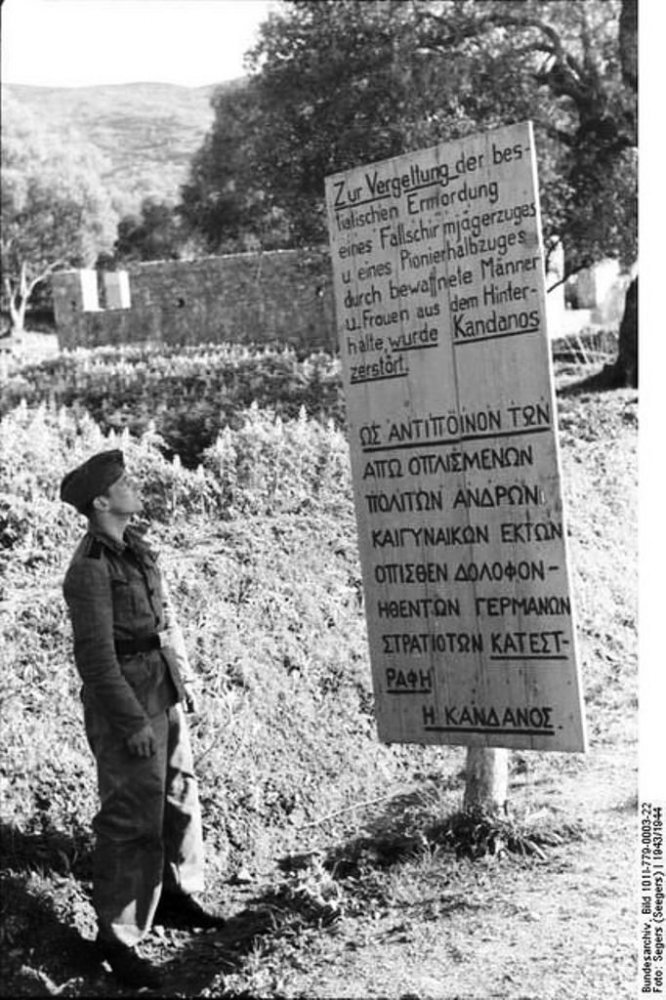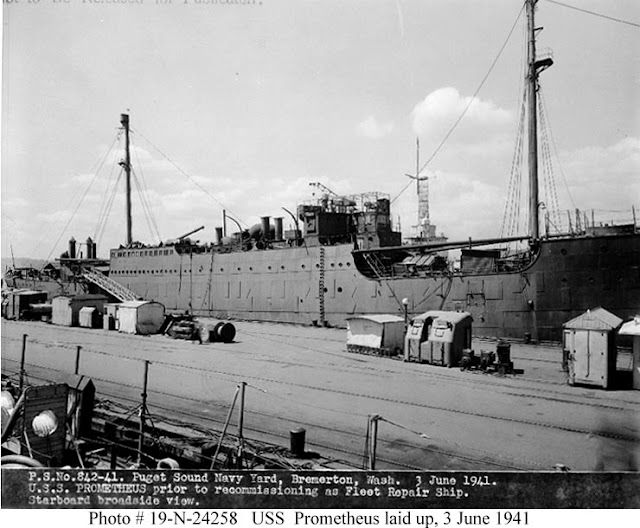Tuesday 3 June 1941
 |
| Japanese Ambassador Hiroshi Oshima Meets Hitler at the opening of the Japanese art exhibition in Berlin in 1939. |
The Vichy French government states that it will defend both Syria and Tunisia against the British.
The British begin stockpiling landing craft and equipment in Port Said for Operation Exporter, the invasion of Syria. Royal Navy troopship Glengyle heads there from Alexandria, while two destroyers (HMS Hotspur and Ilex) leave Alexandria for Famagusta, Cyprus to embark commandos for transfer to Glengyle for upcoming Exporter.
In Iraq, the British continue mopping up. Gurkha troops (2/4 Gurkha Rifles) fly into Mosul and occupy it. Baghdad settles down after the two-day Farhud of 1-2 June, with the British and local police enforcing a strict curfew. The hundreds of dead are being buried.
A private British de Havilland Dragon aircraft unwisely is taken up for private use for a flight between St. Mary's on the Isles of Scillies to Penzance. Unfortunately for the people on the Dragon, a passing German Heinkel He 111 bomber (I./KG 28) on its way back from bombing England spots it. The Heinkel shoots down the Dragon, killing all six aboard, including two girls aged 9 and 11. Pilot Captain W.D. Anderson DFC (Australian) and the entire Leggitt family is killed, including the mother of Mrs. Leggitt. Mrs. Sheelagh Leggitt was the Secretary to Sir Walter Monckton, Director-General of the Ministry of Information. A group of six Hawker Hurricanes of RAF No. 87 Squadron was withdrawn from the island only days before.
East African Campaign: A fierce battle on the approaches to Gondar, a key Italian stronghold in Abyssinia, develops. The British take Debarech, but then the Italians take it back. The town seesaws back and forth, but ultimately the British wind up with it. It is about 100 miles west of Amba Alagi, which fell in May, and the fierce battle shows that the Italians are going to put up a fierce battle for their remaining bastions in East Africa.
 |
| "View of Fleet Tender C, off Lincolnshire Coast." This photograph is from early October 1941 taken from a passing destroyer, HMS Whaddon, while escorting a convoy. You can see how the liner Mamari was disguised to look like an aircraft carrier. © IWM (A 5915). |
U-48 (Kptlt. Herbert Schultze), on its 12th patrol out of Lorient, is operating in the mid-Atlantic west of Brest (650 miles north of the Azores). It is shadowing Convoy OB-327, which recently has dispersed. At 01:01, U-48 torpedoes and damages 9456-ton British tanker Inversuir. Schultze gets impatient and fires a second torpedo at 01:11, then surfaces and uses his deck gun. Some accounts claim that U-75 (Kptlt. Helmuth Ringelmann), also involved in attacks at the same location, actually sinks the Inversuir with a coup de grace torpedo at 03:59. The entire crew survives.
U-75, operating with U-48 in the mid-Atlantic east of Brest and on its second patrol out of Lorient near U-48, torpedoes and sinks 4801-ton Dutch freighter Eibergen. There are four deaths, and 35 survivors are picked up by anti-aircraft vessel HMS Cairo on the 7th.
 |
| SS Prince Rupert City, sunk on or about 3 June 1941 by the Luftwaffe. |
The Luftwaffe bombs and damages 2187-ton British freighter Royal Fusilier in the English Channel east of High Buston. The ship sinks about four miles from May Island. Everyone survives.
The Luftwaffe bombs and damages 1600-ton British freighter Dennis Rose about 50 miles southwest of Start Point. The Dennis Rose makes it to port.
The Luftwaffe bombs and damages Royal Navy minesweeper Franklin as it is laying mines in the North Sea. The damage is not serious and Franklin continues with its mission.
Royal Navy decoy shop Fleet Tender C (formerly the Mamari aka liner Zealandic), disguised as aircraft carrier Hermes, hits a sunken wreck (tanker Ahamo, sunk by a mine on 8 April) southeast of Grimsby. It cannot get unstuck, and during the night, German S-boats attack. The Mamari is a write-off, but the entire crew survives. The half-sunken ship becomes a prominent "landmark" off the coast for years.
A Royal Navy stores ship, City of Dieppe, arrives in St. John's to join the fledgling Newfoundland Escort Force (NEF). The NEF's first convoy operation already is at sea, having sailed on 2 June, but there are very few support facilities in St. John's for the large and growing force. The British and Canadians are making plans to bring more ships and construct shore infrastructure to support the fleet.
Royal Navy battleship Rodney, fresh off the victory over the Bismarck, heads from the Clyde to Boston, the US to refit.
Submarine P.32, damaged on its journey by the Bay of Biscay by air attack, limps into Gibraltar.
Convoy WS 9A (Winston Special) departs from Liverpool en route to Freetown, Capetown, Durban, Aden, and Suez.
 |
| The Inversuir, sunk today in the North Atlantic. |
Royal Navy submarine Unique torpedoes 736-ton Italian freighter Arsia off Lampedusa. The Arsia manages to make it to Trapani, Sicily.
Royal Navy submarine Torbay uses its deck gun to sink a caique carrying oil drum off Mitylene.
Royal Navy motor torpedo boat MTB 215 sinks Turkish schooner Iki Kardeshler a few miles off Anamur, Turkey (north of Cyprus). This is a violation of Turkish neutrality, the Royal Navy explains this by arguing that it thought the ship was involved in covert operations ("false orders").
The Luftwaffe damages a Royal Navy service ship, the KLO, during an air raid on Mersa Matruh. The ship's master and one other man are killed (the other man, Lt. Pullman, dies of his wounds on 2 July).
A large Italian force that includes light cruisers Atttendolo, Duca D'Aosta, and Eugenio D'Savoia of the 7th Cruiser Squadron, and light cruisers Bande Nere and Di Guissano of the 4th cruiser squadron, lays two minefields northeast of Tripoli. This is an area where Royal Navy submarines like to lie in wait for Axis convoys coming and going from Tripoli.
An Italian convoy of six transport ships/freighters departs Naples bound for Tripoli.
On Malta, RAF Martin Maryland and Blenheim bombers of No. 89 and 139 Squadrons on patrol claim to attack a convoy off Tunisia and sink a freighter while setting fire to another. The sunk ships apparently are the Italian freighters Montello and Beatrice C.. The RAF loses a Blenheim during the patrol, hit by flying debris as the first ship hit explodes.
There is one minor bombing raid on Malta by the Luftwaffe which causes no damage, while the RAF claims a victory over an Italian tri-motor transport west of Malta.
Invasion fears are rampant in Malta. The British troops garrison Gozo, normally uninhabited, and practice fighting paratroopers. The War Office issues an alert to expect an invasion within a week by a force of 6000 Axis troops based on spy sources.
The Germans declare Kandanos a "dead zone" which nobody can visit or inhabit. The Germans post two warnings in both German and Greek, one of which reads: "Here stood Kandanos, destroyed in retribution for the murder of 25 German soldiers, never to be rebuilt again." A war memorial using this exact language will be built after the war at the site of the village.
The Germans also attack the villages of Floria and Kakopetro.
Spy Stuff: German Ambassador Graf von Schulenburg is strongly opposed to Operation Barbarossa. He violates his duty by telling the head of Soviet International Affairs that Adolf Hitler had decided to begin a war with the Soviet Union on June 22. The Soviets treat this as proof that the Germans are engaging in a disinformation campaign and that there will not be any invasion.
German/Japanese Relations: Adolf Hitler meets with Japanese ambassador Hiroshi Ōshima at the Berghof. He informs Ōshima of the upcoming Operation Barbarossa. There are some hopes within the German high command that Japan will join Germany in attacking the Soviet Union.
Specifically, agreements are negotiated regarding Finnish use of its army and air force against the Soviet Union in certain circumstances, both of which the Germans consider top quality. Tentative plans are formed for the Germans to occupy northern Finland and use that as a springboard to invade the Soviet Union in the far north and take the Soviet port of Murmansk. The Finns are not doing the Germans any favors - they want assistance to recover their historic territory lost during the Winter War.
The Finns remain wary about granting the Germans a "blank check." Heinrichs even warns them that any attempt to mount a coup in Finland and install a puppet government favorable to Germany would be met with absolute resistance. However, overall the talks are cordial and the Finns begin preparations for some kind of military activity. Based on the agreements reached at this meeting, Luftwaffe transport planes carrying service personnel begin arriving at Finnish airfields.
While the Germans are coy about the likelihood of Operation Barbarossa, it is hard to believe that the Finns can't figure out that the Germans intend to invade the Soviet Union, and soon.
These meetings last until 6 June.
German/Vichy France Relations: Premier Petain, supported by his Council of Ministers, refuse to ratify Vice Premier Admiral Darlan's recently negotiated Paris Protocols. However, they have gone into effect anyway.
 |
| "HMS SUFFOLK's Supermarine Walrus amphibian taxi-ing back to the ship after a flight over the Arctic ice. Ice can be seen in the background." June 1941 on Arctic patrol in the Denmark Strait. © IWM (A 4185). |
British Government: A memorandum drafted by Clement Attlee which provides that "A necessary prelude to a just peace is a total victory" is approved at a Labour Party conference by 2,430,000 to 19,000.
China: The new Nakajima Ki-43 Type 1 Fighter ‘Hayabusa’ (Allied codename "Oscar") is allocated to the Japanese 59th Sentai at Hankou. The unit begins transferring them from Japan. The Ki-43, however, turns out to have wing problems that requires repair.
 |
| Aerial view of the construction progress of Camp Polk, Louisiana on 3 June 1941. |
June 1941
June 1, 1941: Farhud Pogrom
June 2, 1941: Massacres on Crete
June 3, 1941: Kandanos Massacre
June 4, 1941: Kaiser Wilhelm Passes Away
June 5, 1941: Death in Chungking
June 6, 1941: Hitler's Commissar Order
June 7, 1941: Commandos Strike at Pessac
June 8, 1941: British Invade Syria and Lebanon
June 9, 1941: Litani River Battle
June 10, 1941: British Take Assab
June 11, 1941: Hitler Thinking Beyond Russia
June 12, 1941: St. James Agreement
June 13, 1941: Lützow Damaged
June 14, 1941: Latvian June Deportations
June 15, 1941: Operation Battleaxe
June 16, 1941: The Old Lion
June 17, 1941: British Spanked in North Africa
June 18, 1941: Turkey Turns Its Back
June 19, 1941: Cheerios Introduced
June 20, 1941: Birth of US Army Air Force
June 21, 1941: Damascus Falls
June 22, 1941: Germany Invades Russia
June 23, 1941: A Soviet KV Tank Causes Havoc
June 24, 1941: Kaunas and Vilnius Fall
June 25, 1941: Finland Declares War
June 26, 1941: Bombing of Kassa
June 27, 1941: Encirclement At Minsk
June 28, 1941: Minsk Falls
June 29, 1941: Brest Fortress Falls
June 30, 1941: Mölders Becomes Top Ace
2020



No comments:
Post a Comment